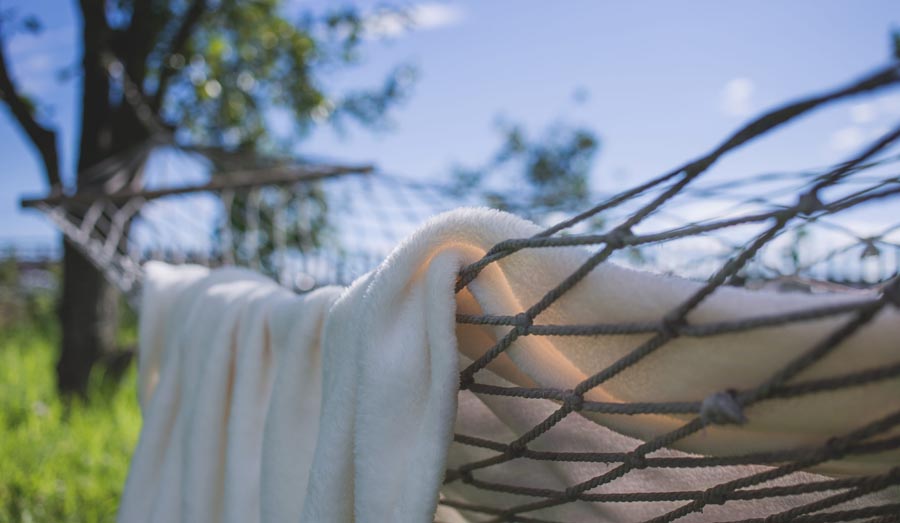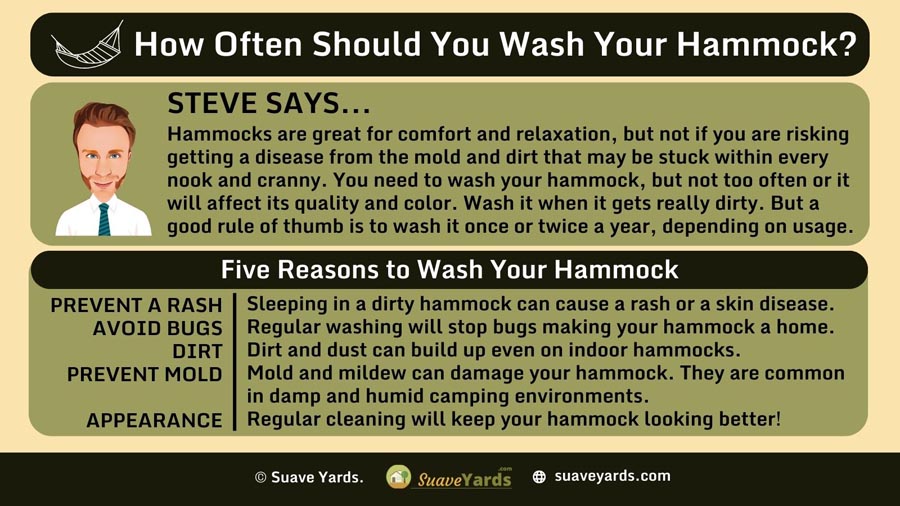
Do you need to wash your hammock?
You do!
But you have to remember, hammocks are not like clothes. You don’t need to wash them every time you use them.
Still, you might ask: How often should I wash my hammock?
The answer isn’t always as straightforward.
The good news is, we have the goods! Let’s find out hiw often you should wash your hammock.
Hammocks are great for comfort and relaxation, but not if you are risking getting a disease from the mold and dirt that may be stuck within every nook and cranny. You need to wash your hammock, but not too often or it will affect its quality and color. Wash it when it gets really dirty. But a good rule of thumb is to wash it once or twice a year, depending on usage.
Why Do You Need To Wash Your Hammock?

Obviously, hammocks get dirty, so they need to be washed.
But let’s dig deeper…
Prevent Skin Rash or Disease
When you go camping or backpacking, chances are you won’t have a chance to shower or bathe every day.
As you get dirty, so does your hammock, which is your chair, bed, and home all at once while camping.
Imagine muck on the hammock getting into your skin.
People with sensitive skin may have allergies from sleeping in dirty hammocks.
That’s why you really need to wash your camping/backpacking hammock to prevent skin rashes or diseases.
Prevent Bug Infestation
One of the many advantages of using a hammock during camping is that it is hung on trees.
You get respite from crawling insects, snakes, and other creepy animals.
But bugs can fly and lurk in your temporary shelter.
It’s always a good idea to camp with a bug net, but that doesn’t mean bugs won’t be clinging to your hammock.
Washing the hammock will remove the pesky bugs that may go home with you.
Sometimes, the hammock will need more than just deep cleaning; it may need treatment too.
Permethrin is an insecticide recommended by the Centers for Disease Control and Prevention (CDC).
Prevent Dirt Buildup
Home hammocks that are not used often still need cleaning.
Even indoor hammocks have to be cleaned to prevent dirt buildup.
Prevent Mold Growth

Mold and mildew are common in damp and humid environments.
Do hammocks get moldy?
They do, but you can prevent that by cleaning your hammock.
In cases where there is already mold growth, you need to treat it with a vinegar solution.
Mold and mildew can damage your hammock, which may also stink during development.
Plus, it will also blemish the hammock’s aesthetics.
Maintain Appearance
Dirty hammocks look dirty!
Clean the hammock so it will look clean and as close to its original appearance as possible.
Now, let’s get onto the topic:
How Often Should You Wash Your Hammock?
Washing your hammocks has its pros and cons.
Obviously, the most important pro is that a clean hammock will prevent rashes, bug bites, dirt buildup, and molds.
And while cleaning a hammock ensures it will look close to its original appearance, washing it would also contribute to the opposite result.
Washing the hammock will cause the colors to fade.
But aesthetics are not the most important thing when it comes to hammocks, it’s their function.
However, washing the hammocks too often will compromise their material.
The cleaning solution may weaken the hammock material.
When it happens, the hammock will easily get a tear and it would be almost difficult to repair it.
The Rule of Thumb
Cleaning it twice a year is a good rule of thumb.
However, if it gets really dirty, then you should clean it immediately after use.
Take this Reddit user who got their hammock through the wringer:
“The five of us just finished an almost 4-week hammock camping trip. Limited showers (thanks Yellowstone! ), lots of hiking, campfires, diesel smoke from the truck bed, eating in them, etc. How do I wash the 5 hammocks? They were our only chairs, beds, hauled from site to site, etc. They are cheapos from Amazon, Kootex (new), and Honest Outfitters (from 2018). Really they are rank, not as bad as the sleeping bags, but still.”
In this case, the hammock must be cleaned the moment one gets home.
But how does one go about cleaning a hammock?
How To Clean a Hammock
Since hammocks are made of different materials, there are also different ways to clean them.
Let’s go through the various ways to clean a hammock and figure out the best way to clean it, according to its material.
Remove Dirt By Shaking It Off
Simply shaking off the hammock can remove dirt and bugs, not thoroughly, but it will do after every use.
To do it, hold one end of a hammock and shake it vigorously to remove as much dirt and bugs as possible.
Follow Cleaning Instructions
Most hammocks come with care instructions.
The best way to clean a hammock is to follow the manufacturer’s instructions since they know best.
Some hammocks are machine washable.
Washing a Hammock in the Machine
Hammock loops or strings may get entangled during the wash.
The best way to wash a hammock in the machine is to put it in a pillowcase and tie it closed. Make sure the binding tie isn’t loose.
Use a small amount of mild detergent, otherwise, it would be too harsh for the hammock and may affect its quality.
Don’t use bleach and fabric softener.
Don’t use stain removal chemicals either. Stain removers can be used when hand washing the hammock.
Moreover, don’t use the dryer. Hang the hammock to dry in the sun instead.
Hammocks with non-removable spreaders should not be put in the wash.
Instead…
Cleaning a Hammock With Spreaders
Some hammocks have removable spreaders, but others don’t.
In this case, you need to handwash the hammock.
First, spread out the hammock on a smooth and flat surface.
Second, create a mild cleaning solution, such as a bucket of warm water mixed with a little bit of mild detergent.
Third, wet the hammock and then brush it with your cleaning solution.
Fourth, flip the hammock and do the same thing, brush it with the cleaning solution.
Finally, rinse the solution off the hammock and hang it up to dry in direct sunlight.
If the hammock has a stain, spray it with stain remover before using the cleaning solution.
Washing a Hammock in the Tub
One of the most popular ways to clean a hammock is by putting it in the bathtub. It is more appropriate for hammocks without spreader bars or those with removable spreader bars.
How is it done?
Simply submerge the hammock in the tub half-filled with warm water and a mild cleaning solution.
Massage the hammock in a bid to wring off dirt, bugs, and other elements.
Rinse the solution off the hammock, squeeze out the excess water, and hang it out to dry.
Based on many online threads about cleaning hammocks, washing them in bathtubs is the most popular.
How To Clean Hammocks by Material

Different hammock materials need different care. Here is how you can clean some of them:
Rope Hammock
Wash it by hand. Whether you do it on a clean surface or in a tub depends on whether it has removable or non-removable spreader bars.
Quilted Hammock
Wash it by hand and with a brush that can get through every nook and cranny of the quilt.
Camping Hammock
Since camping hammocks are usually made of lightweight materials, you need to be gentle with them.
Washing by hand is the best way.
Use a gentle brush when you scrub off the dirt too.
You don’t want to impair the quality of a camping hammock, which becomes your temporary home during camping and backpacking trips.
Cotton Hammocks for Indoors
Many simple indoor hammocks are made of cotton fabric that can be easily washed in a machine. But hang it out to dry rather than using the machine.
Final Thoughts

Everything that we use needs to be cleaned and hammocks are no exception.
However, you have to be more purposeful when cleaning hammocks because too much washing could affect their durability.
You don’t want to reduce its strength because you may end up with your butt on the ground.
Wash your hammock when needed, which is based on an individual’s judgment.
But a good rule of thumb is twice a year.
Remember, a clean hammock keeps you more relaxed because it doesn’t stink and dirt buildup and bug bites are greatly reduced.
